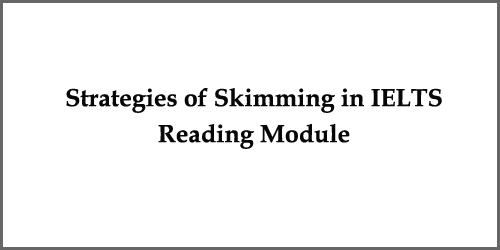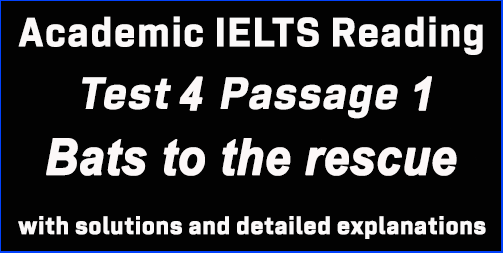Strategies of Skimming in IELTS Reading Module
Skimming is a very common word in IELTS Reading Module. Yet, many find it difficult to understand the concept of skimming or to do it. Some strategies may help you here. So, I’ve discussed some essential skimming strategies below.

What is skimming?
Skim means to read, study, consider, treat, etc. in a superficial or cursory manner. We can get the idea from here that Skimming is the technique of reading quickly to get a general idea about something. It means not to read for gathering the complete idea of something, but rather, reading for the sake of getting a bird’s eye view.
How to do Skimming?
Consider the following steps for becoming an expert in skimming.
- Target the headline of the passage. Most of the time, it gives you a general sense of the total passage. If there is any sub-heading just under the heading, don’t forget to have a look.
- The next step is to read the opening sentences of every paragraph. It is customary for good article writers to include the main idea of each paragraph at the very opening. So, have a quick look. You can do it two times if you are new to Reading Module.
- Use your pencil. Underline the words which you think as significant. It might not actually be, yet don’t forget to underline them. This will help you get a common idea of what is being discussed.
- Overlook words that are unfamiliar to you. Many students waste their time looking at unknown words. They don’t help you, rather they kill your valuable time.
- Identify and underline words that have some sort of connection. (i.e. food, restaurants, cuisine, table-manners, reception, hospitable, etc.- all these words are related to eating out)
- Always remember not to become busy with the details of the paragraphs.
Here’s an example of how to apply skimming to a sample question:
Look at the following passage:
Climate change is a pressing global issue with far-reaching consequences. It is primarily caused by a combination of natural processes and human activities. One major cause of climate change is the increased emission of greenhouse gases, such as carbon dioxide (CO2), methane (CH4), and nitrous oxide (N2O). These gases trap heat in the Earth’s atmosphere, leading to a phenomenon known as the greenhouse effect.
Human activities contribute significantly to the rise in greenhouse gas emissions. The burning of fossil fuels, such as coal, oil, and natural gas, for energy production and transportation, is a key contributor. Deforestation, especially in tropical regions, also plays a crucial role as trees absorb CO2 and help regulate the climate. Additionally, industrial processes, agriculture, and waste management practices release substantial amounts of greenhouse gases into the atmosphere.
It is important to note that natural factors also influence climate change. Volcanic eruptions, for example, release large amounts of gases and particles that can temporarily cool the Earth’s surface. Solar radiation variations and natural climate cycles, such as El Niño and La Niña, also impact global climate patterns.
Overall, the major causes of climate change can be attributed to the increase in greenhouse gas emissions resulting from human activities, particularly the burning of fossil fuels and deforestation. Understanding these causes is vital in developing effective strategies to mitigate and adapt to the challenges posed by climate change.
Sample Question: “According to the passage, what are the major causes of climate change?”
- Begin by quickly scanning the passage for keywords related to climate change. Look for headings, subheadings, or any sections that mention causes or factors contributing to climate change.
- Skim the first sentence of each paragraph to identify any information related to the causes of climate change. Focus on words like “causes,” “factors,” or specific causes such as “greenhouse gases” or “deforestation.”
- Pay attention to any highlighted or bolded text that might indicate significant causes or factors.
- Use your peripheral vision to move your eyes across the lines, picking up on keywords or phrases that relate to the causes of climate change. Look out for words like “emissions,” “pollution,” “industrialization,” or “human activities.”
- Skip any detailed explanations or examples that may not directly address the causes of climate change, as skimming is about identifying the main points quickly.
- Once you have gathered a general understanding of the passage and identified a few major causes of climate change, you can go back and read those sections more carefully for detailed information and supporting evidence.
By applying skimming techniques to this sample question, you can quickly identify the main causes of climate change mentioned in the passage. Skimming allows you to efficiently locate relevant information and save time during the IELTS Reading module.
It will take some time to be accustomed to Skimming in IELTS Reading Module. Don’t be hopeless if your progress is slow. Keep working. You will be habituated eventually.
Happy IELTS!
6 IELTS Preparation Tips for Reading Section
IELTS Reading: 10 steps which helped me to score 8.0 in Reading
Strategy for IELTS Reading: TRUE, FALSE, NOT GIVEN or YES, NO, NOT GIVEN
Click here for solutions to Cambridge Test 6; complete speaking test
IELTS Speaking Part 2: A teacher who has greatly influenced your academic life
Cambridge IELTS 12 Test 5; complete the Speaking test with model answers
IELTS Speaking Part 2: Something useful you learned from your family



